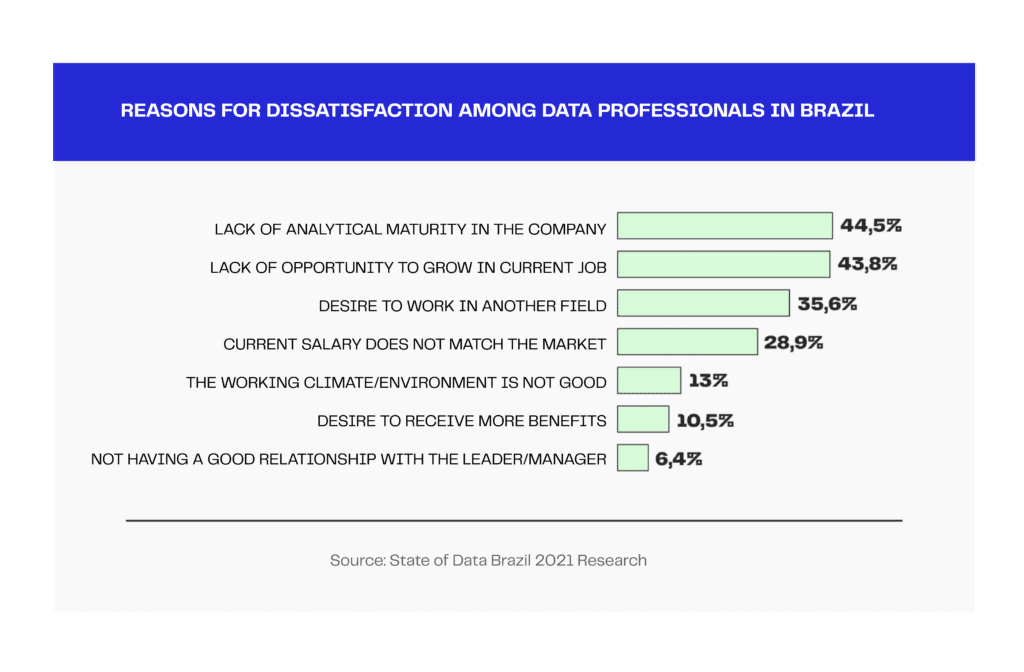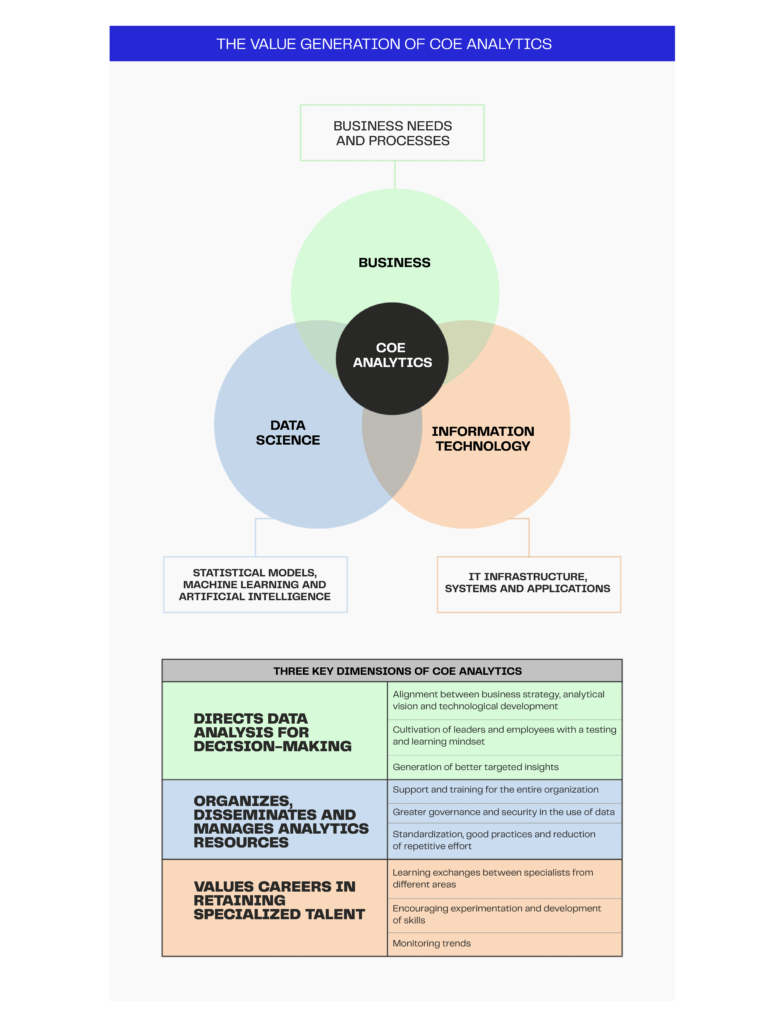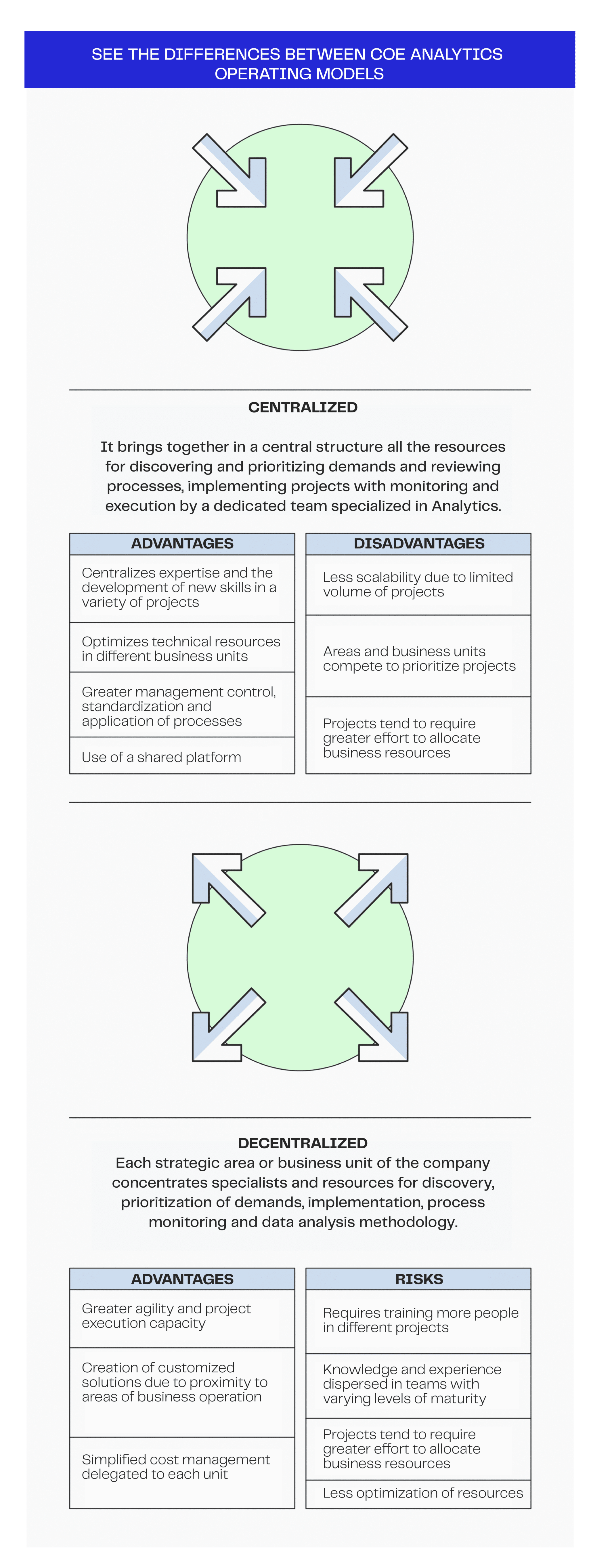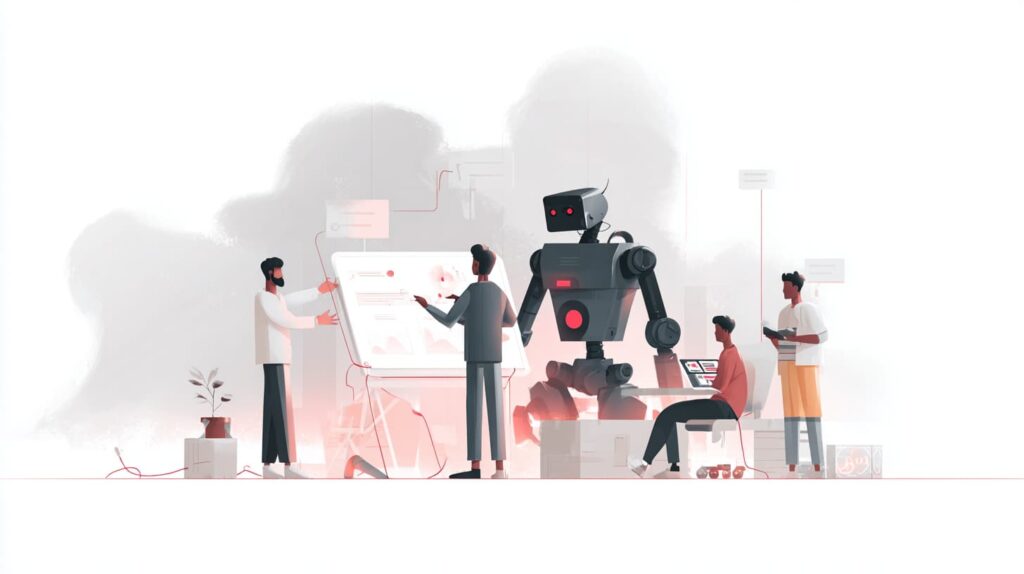By EloInsights
- In a scenario in which the relevance of Advanced Analytics is only growing in all companies due to the proof of its earning potential, added to the Digital Transformation scenario, structuring your Analytics area has become mandatory.
- One of the best practices for this structuring is the creation of a CoE Analytics to organize, optimize and standardize Advanced Analytics processes.
- Its role is also linked to the dissemination and orientation of the test and learn mindset and the valorization of talents in data science careers.
In a scenario of constant change and the rapid introduction of disruptive technologies, it is essential that organizations develop a strong data-driven culture. Decision-making must increasingly be supported by a greater volume and quality of data, opening a vast horizon of possibilities.
According to a McKinsey study, the potential value of applying AI and Analytics in various areas ranges from US$ 9.5 trillion to US$ 15.4 trillion – from advanced electronics and semiconductor production, through the automotive industry, the basic industry, consumer goods – as well as the public and social sectors, security, retail, transport and logistics, among others. The amount indicates that companies have an unprecedented opportunity to make real gains with the best use of data intelligence.
“Everyone wants a data-driven company. To achieve this, there are various models and it will certainly be necessary to employ more tools, as well as more engineers to deal with the massive amounts of data”, explains Gabriel Renault, executive director of technology and advanced analytics at EloGroup.
This trend goes hand in hand with the growing focus on professionals and demands in the areas of Advanced Analytics & AI, the need for greater robustness and contextualization in generating insights for decision-makers – who are no longer just the leaders of organizations.
However, companies still have doubts about the best organizational structure to accommodate these new needs. In this context, the implementation of a Centre of Excellence in Analytics (CoE Analytics) is a good practice.
It is important to highlight the difference between Analytics and Advanced Analytics. The former involves Business Intelligence, a practice in which many companies have accumulated two or three decades of experience. In simple terms, it refers to the use of dashboards to group and visualize data. Advanced Analytics, on the other hand, is about implementing algorithms; mechanisms with an extra layer of intelligence that give more complete answers for analyses. It is at this more advanced stage that the Centre of Excellence runs.
A CoE brings together engineers and data scientists to analysts and business executives as a highly efficient support for sharing knowledge and structuring Advanced Analytics processes. These specialist individuals are managed from a central structure, responsible for leading the best application of AI to generate value for the company, as well as centralizing the exploration and adoption of new tools and technologies.
In this sense, CoE Analytics incorporates AI as a lens aimed at generating maximum value without wasting resources. It also breaks down barriers and is an enabler of digital transformation – and of a Strategically Digital stance – by working on key points such as:
- Leadership and employee acculturation;
- Structuring of the Advanced Analytics work model throughout the company;
- Greater agility in deliveries;
- Change in the management model; and
- Attracting and keeping today’s highly sought-after talents such as Data Scientists, Data Engineers and Machine Learning Engineers.
Generally speaking, research has shown for more than a decade that a company with a consistent capacity for analysing data can be at least 5% more productive and 6% more profitable compared to its competitors. But it has been in recent years that the spread of Centres of Excellence has intensified globally, in what can be read as a response to this escalation in the use of data science in different areas of organisations and to the high demand for qualified labour, which is more expensive and has specific interests.
According to the State of Data Brazil 2021 survey, data professionals in Brazil have an elevated level of education, from junior level upwards. And even if they are satisfied in their jobs, 40.2% stay open to other offers, while 22.7% are actively looking for vacancies. Among the biggest points of dissatisfaction for these professionals: the lack of analytical maturity in organizations (cited by 44.5%) and the scarcity of growth opportunities (43.8%).
“These are professionals who are scarce in the market, as well as demanding, and who like to promote a constant exchange of technical learning”, states Renault. The director already sees an increase in demand from large companies in Brazil to implement CoE Analytics.
Generating value: business, analytics and IT
In the challenge of acculturating the company to data-driven decision-making, it is essential to invest in the human factor and not just priorities technological development. To this end, the Analytics Centre of Excellence bridges the gap between three core skills: business, data science and technology.
It brings together the need for processes linked to the end business, the availability of Data Architecture and Advanced Analytics capabilities related to the application of statistical models, machine learning and artificial intelligence to solve problems that generate tangible value for companies.
The CoE plays several roles, including: aligning the Advanced Analytics vision with the company’s business strategy; improving advanced data analysis ability throughout the organisation; providing greater data governance and quality; developing good practices and standardisation for more agile and reliable analysis; reducing repetitive effort; checking trends and attracting; and keeping talent with high technical and analytical capacity.
We can group these roles into three main dimensions:
1. Directs data analysis towards decision-making
It is common to link data analysis to technological capabilities, but, in fact, as the name implies, Data Science is a science which premise is to be empirical. When scientific methods are no longer confined to R&D areas, there is a change in thinking. “There is a whole method for dealing with this. You need to acculturate the company and make employees feel that they are protected from a more traditional mindset; that they are in an environment where they can make mistakes, because denying hypotheses is also a result of the models”, says Renault.
The implementation of a CoE helps with this breakthrough, as it promotes the adoption of a new mindset, in which data-driven decision-making is linked to experimentation and the logic of testing and learning. In a direct way, it forms a team that brings data science closer to the business areas through processes and methodologies so that its application goes far beyond good models, because it changes the culture and way of working.
Advanced data analysis is taken to another level by being integrated with an executive vision, which will guide what will be done, as well as technical expertise, that will figure out how it will be done. Executives, business intelligence specialists, data architects and engineers, system administrators and data scientists work within the same strategy to generate insights, which maximises results in extracting value and improving business performance.
2. Organize, disseminate and guide analytics resources
The center of excellence makes it possible for several types of data to be ready at the right time and in the right format for different areas of the organization. In general terms, it develops and improves the ability to analyze data in a more uniform way.
To do this, it works together with IT to evolve the technological infrastructure, which includes implementing repositories for structured, semi-structured and unstructured data – data lakes and data warehouses – to create a reliable source of information. The protection of confidential information must also be considered, with authentication and access authorization levels that prevent breaches.
There is also the definition of governance mechanisms: what data will be collected, how it will be grouped and cleaned, where and how it will be stored and how it will be integrated into the various systems that will make it easier for other teams to read the analyses. The dissemination of Advanced Analytics concepts must be an important pillar of an effective CoE, with practical and on-the-job-training aimed at transforming the culture through concrete results.
3. Value careers in retaining specialised talent
A shortage of skilled professionals can jeopardise companies’ ability to form teams and, consequently, create a culture of data-driven decisions. Although there are specific needs in relation to all this coordination of areas and processes, it is important to ensure that the centre of excellence can play the role of attracting and valuing people specialised in Advanced Analytics.
Attracting and retaining talent requires support from top management for a flexible organisational culture that calibrates the offer of benefits and career progression. Having a cadre of people with advanced analytics knowledge and a strategic business vision requires being open to allowing them not only to perform standard functions, but also to have room to experiment, develop skills and explore innovations, whether it is entering new markets or creating products and services.
Different operating models
When we talk about the Analytics Operational Model (AOM), we are defining how the management and coordination of the general rules of this entire universe of analytical capacity will be carried out.
This can begin with the formation of a squad or a working group. The first structure tends to be centralized for reasons of resource allocation and project maturity. Over time, the discussion can move forward, keeping a single structure or decentralizing it to coordinate several CoEs in the company.
A centralized CoE will priorities company’s big issues, so it tends to connect to the core business as a more direct path to exponential gains. For example, in a factory, a small improvement in the efficiency margin can save millions of dollars on the production line.
However, Gabriel Renault advocates moving towards a more decentralized structure to increase execution capacity and project diversification. In the last two years, especially with the impact of the Covid-19 pandemic, companies have seen an explosion in cases of burnout and other issues involving the mental health of their employees that can be mitigated by analyzing data. “Companies want to understand this phenomenon. And then, if you have a central CoE, other areas join the queue and can suffer from a lack of prioritization”, explains.
Therefore, if a mining company has a centralised CoE, it will probably be focused on solving issues related to the handling and transformation of ores. Thus, an issue like People Analytics, which requires collaborative data, takes a back seat, even though it also brings huge gains when studied. By decentralising the operating model, each area or business unit can take data analysis to the next level, without affecting the core.
There can also be intermediate tones, in a hybrid model. For example: a centralized CoE that periodically gathers learnings to evolve processes, but with the projects being applied in a distributed way in the different areas of the company. Or the opposite: with demand discovery and analysis processes carried out by the departments and implemented by the central CoE.
Generally, the company’s priorities, the need to balance the supply and demand of analytics skills and the maturity of the analytics ability all point to the definition of the operating model. The main goal is to set up a data-driven culture. Having a strong Analytics backbone makes this possible, even if it comes with a high and complex investment. In a world where the ability to compete and the need to reinvent oneself count for more, it can be a decisive differentiator to mitigate the inevitable and constant transformations of the organisation.














